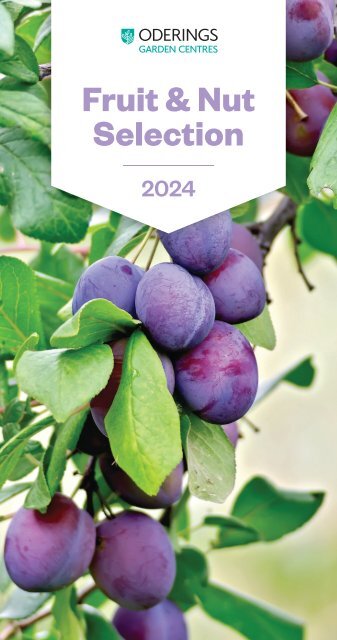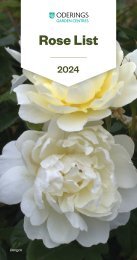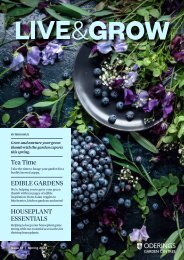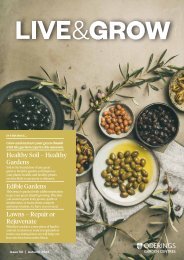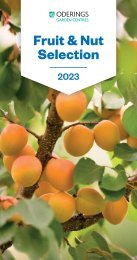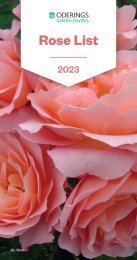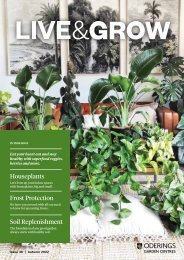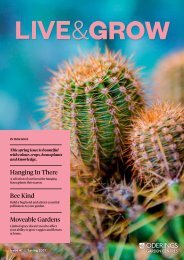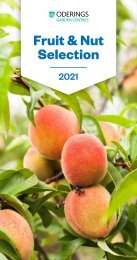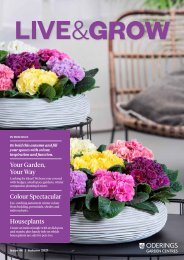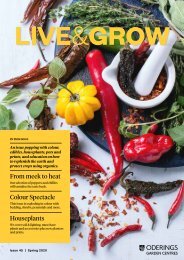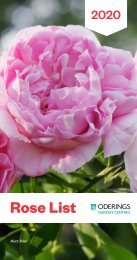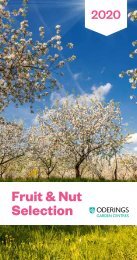Fruit & Nut Selection 2024
Discover our wide array of fruit and nut trees available, including apples, pears, plum trees, and many more options.
Discover our wide array of fruit and nut trees available, including apples, pears, plum trees, and many more options.
Create successful ePaper yourself
Turn your PDF publications into a flip-book with our unique Google optimized e-Paper software.
<strong>Fruit</strong> & <strong>Nut</strong><br />
<strong>Selection</strong><br />
<strong>2024</strong>
ALMOND<br />
Most almonds are self-fertile and do not require a cross-pollinator.<br />
All In One – Number one for home orchards. Heavy crops of soft-shell<br />
nuts with sweet, flavourful kernels. Hot summer required to ripen. A five<br />
metre tree, very winter and frost hardy. Self-fertile.<br />
Garden Prince – A delightfully compact-growing tree that is both very<br />
ornamental and fruitfully productive. It commences fruiting from a<br />
young age and has very heavy crops. Grows to approximately 3m tall<br />
and 2.5m wide and is self-fertile.<br />
IXL – Producing large oval nuts that have a sweet flavour. The tree has a<br />
neat upright habit and is a great producer. Partially Self-fertile. Pollinate<br />
with Monovale. NI ONLY<br />
Monovale – produces hard-shell nuts with good flavour. Due to their<br />
strong flavour this variety can be used for Marzipan. A heavy cropper<br />
and good pollinator. Disease hardy variety. Vigorous grower, self-fertile.<br />
APPLE<br />
In most areas apples are often pollinated by other apples or crabapples<br />
close by. If unsure, you will need to plant two varieties that cross<br />
pollinate. Please see in-store details.<br />
• M9 = dwarf fruit tree growing to 3m. Suits well drained, fertile soils.<br />
Not suitable for heavy clay soils.<br />
• MM102 = similar to MM106 but performs better in wetter sites.<br />
• MM106 = Semi dwarf fruit tree growing to 4.5m. Good for most soils<br />
except poor-draining sites.<br />
• M26 = Proven industry work horse. Recommended for high density<br />
plantings on all sites except poorly drained soils.<br />
Single Apples<br />
Baujade MM106 – French Granny Smith–type apple ripening late in<br />
the season. Medium sized, sweet and aromatic. Well suited to warmer<br />
areas. SI ONLY<br />
Ballerina Bolero – Attractive white-tinged pink spring blossoms with<br />
shiny green eating apples with a golden blush. Mid-season. SI ONLY<br />
Ballerina Polka – Medium-size round fruit with green skin. A red blush<br />
develops in areas exposed to the sun. The flesh is crisp and juicy with a<br />
very good flavour. Matures mid-season.<br />
Ballerina Waltz – Medium to large round-conical fruit with a solid red<br />
skin on exposed areas. Crisp and juicy with a slight tang. Suitable for<br />
fresh fruit, drying and cooking. Matures mid-season. SI ONLY<br />
Blush Babe 60cm Standard – Growing to just two metres tall with a<br />
mop-head habit, this dwarf apple variety produces delicious full-size<br />
crispy red fruit. Good natural disease resistance means little spraying is<br />
required, and little or no pruning is needed. Self-fertile.<br />
Braeburn M9, MM102 or MM106 – Braeburn apples have a unique<br />
combination of sweet and tart flavour and are medium to large in size.<br />
They are a popular fruit for growers because of their ability to store well<br />
when chilled.<br />
Bramleys Seedling MM106 – A heritage apple of medium to large size.<br />
The fruit is round and has a distinctive conical shape. It has a firm, tart<br />
flesh with a good flavour and is sweet with plenty of juice. Keeps very<br />
well. Tip and spur bearing mid to late season. SI ONLY<br />
Coxs Orange Pippin M9 or MM106 – One of the finest apples ever<br />
grown. Rich aromatic nutty-flavoured flesh makes this older variety still<br />
a hugely popular apple. Early to mid-season. SI ONLY<br />
Egremont Russet MM106 – Mild sweetness with moderate acidity<br />
and light, cottony, crisp flesh – very similar to Royal Gala. Late summer<br />
picking. Best flavoured when refrigerated for up to three months. Black<br />
spot resistant. SI ONLY<br />
Fuji M9, MM102 or MM106 – Super sweet, super juicy, super crisp<br />
Japanese apple. Stores very well for several months. Colour ranges from<br />
light green-yellow with a small amount of red, to fully red.<br />
Gala M9, MM102 or MM106 – A crisp apple with a rich flavour, Gala is<br />
always an early-season treat. Reddish-orange skin striped over a yellow<br />
background. This popular apple settles on a rich flavour accompanied by<br />
crisp, dense and aromatic flesh that is a fantastic combination of sweet<br />
and tart. Requires 600 chilling hours to set fruit. Tip bearing.<br />
Golden Delicious M9 or MM106 – World famous apple with great taste,<br />
texture, aroma and appearance. Honeyed flavour, very sweet especially<br />
when tree ripened. Heavy and regular producer in late season. SI ONLY<br />
Granny Smith M9, MM102 or MM106 – Aussie classic with large green<br />
fruit with white tart crisp and juicy flesh. Well balanced flavour. Late and<br />
long picking season. Excellent keeper. Regular bearer that suits most<br />
climates.<br />
Harold Red Delicious MM102 – This is a NZ selection of the popular ‘Red<br />
Delicious’. The skin is a very deep red colour and the aromatic, juicy flesh<br />
is coloured cream. Ripens in autumn. NI ONLY<br />
Hetlina MM106 – Reliable crops of medium-size firm and crisp red fruit<br />
that are good eating. Early season apple on high-health tree. SI ONLY<br />
Initial M9 or MM106 – An exceptionally good eating early red apple with<br />
high aroma, low acid and high sugar. Easy to grow and tolerant to a large<br />
range of apple diseases and pests. SI ONLY<br />
Kingston Black – A late season, heritage cider apple with dark red fruit<br />
which produces a bitter-sweet juice. Please note this is not an eating<br />
apple. SI ONLY<br />
Lady in Red (Pink Lady) M9 or MM102 – Lady in Red’ tree bears fruit<br />
that is pink-red blushed with pure white flesh and is capable of producing<br />
fruit that meets the high quality standards of PINK LADY® apples, one of<br />
the world’s most popular varieties. <strong>Fruit</strong> from this ‘Lady in Red’ tree has a<br />
flavour balanced between tartness and sweetness, with a crisp texture<br />
and sensational aroma.<br />
Monty’s Surprise M9 or MM102 – Crisp, good eating, late-ripening apple<br />
that also cooks well. <strong>Fruit</strong> can be very large on a vigorous, high-health tree.<br />
<strong>Fruit</strong> shiny red over light green background.<br />
Mother In Law – A late season, heritage cider apple which produces a<br />
sharp taste. The Green-bronze skin has a red blush and ripens in March-<br />
April. Please note this is not an eating apple. SI ONLY<br />
Pacific Rose M9 or MM106– This pink-skinned pleaser is firm and juicy,<br />
with a rich sweet flavour that won’t disappoint. This New Zealand variety<br />
has distinctive, clear rose-pink skin. The flesh is firm, crisp and juicy with a<br />
rich sweet taste. A Gala and Splendour cross, this apple reaches maturity<br />
mid-season.<br />
Peasgood’s Nonsuch M9 – Juicy fresh-eating apple with large regular<br />
shape. Cooks to a sweet delicately flavoured puree but also great<br />
baked or used in salads. Good regular cropper and reasonably diseaseresistant<br />
tree.<br />
Royal Gala M9, MM102 or MM106 – This NZ-bred apple now surpasses<br />
Cox Orange as Britain‘s most popular eating apple. Creamy, fine textured,<br />
crisp, sweet and juicy flesh. Regarded as one of the world’s finest apples.<br />
Matures in February.<br />
Slack ma Gridle – A late season, heritage cider apple which produces<br />
fruit of a flattened shape with a greenish yellow skin with a stripped red<br />
flush. The flesh is extremely sweet and can be used for cooking, fresh or<br />
cider. NI ONLY<br />
Splendour M9 or MM102 – Beautiful, large and blocky, carmine-red<br />
apples with creamy, very crisp flesh. Sweet and very low acid. Ripens late<br />
and hangs on the tree well. Fabulous winter keeper.<br />
Sturmer MM106 – Clear white flesh with blush bronze over green skin.<br />
Excellent cooking and dessert quality apple. Mid to late-season variety<br />
that is partially self-fertile. Heavier crops are produced when pollinated by<br />
2 SI – South Island, PN – Palmerston North, HN – Havelock North<br />
www.oderings.co.nz<br />
3
another variety of apple such as Cox’s Orange Pippin, Discovery, Granny<br />
Smith, Jonathan, Kidd’s Orange Red and Scarlet Nonpareil. SI Only<br />
Thumbelina Mini Apple Candy Crunch – A new variety with bite-sized<br />
apples. The fruit is ripe after the leaves have fallen in autumn, usually<br />
in May in most regions. Sweet, crisp and juicy fruit with bright red skin.<br />
Pretty white and pink spring blossoms. Growing to just 2m tall. SI Only<br />
Tom Putt – This dual-purpose cider apple can also be used for cooking<br />
and eating with a sharp flavour. A good crop of fruit is ready in autumn<br />
and have a large, flattish appearance with green, flushed-red skin.<br />
Double-Grafted Apples<br />
Double Delicious – Superb in spectacle and great eating, has both the<br />
golden and the red Delicious varieties. SI ONLY<br />
Royal Gala/Braeburn – Two hugely popular varieties that are excellent<br />
keepers when stored.<br />
APRICOT<br />
Most apricots are self-fertile; however, they will fruit more heavily and<br />
regularly if cross pollinated.<br />
Aprigold – Bears full-size, early season, highly coloured, tangy<br />
flavoursome fruit. Grows to only 1.8m. Well suited to warmer areas of NZ.<br />
Self-Fertile.<br />
Castlebrite – A semi-sweet apricot, which is medium in size, reliable and<br />
early fruiting with firm, bright orange fruit with a slight red blush. NI ONLY<br />
Cluthagold – A cross between Sundrop and Moorpark. Cluthagold is a<br />
large, oval apricot with very good eating quality. Flesh is firm but melting,<br />
with very good flavour. Skin is orange with a lovely red blush. SI & HN ONLY<br />
Cluthalate – A self-fertile, late season variety that ripens 30 days after<br />
Sundrop and 14 days after Moorpark. Its orange fruit is of medium size,<br />
with melting flesh that is sweet and juicy. Best grown in areas with cold<br />
winters and hot, dry summers. SI ONLY<br />
Fitzroy – Bred in Taranaki this Apricot has consistent crops of medium<br />
sized golden fruit that ripen around February. The fruit are sweet and<br />
juicy, and the tree is self-fertile. Happiest in the sun with good drainage.<br />
Prune after harvesting. NI ONLY<br />
Garden Annie – An early season fruiting variety, with good sized bright<br />
yellow fruit that is firm and juicy and semi-freestone. A highly ornamental<br />
tree that is semi-dwarf so is well suited to home gardens, especially in the<br />
warmer areas of the country<br />
Katy Cot– Large, all-purpose flavourful freestone apricot well suited to<br />
warm winter climates. Tree ripened fruit are incredibly good eating and<br />
also make excellent jam. Early harvest. Self-fertile. Semi-dwarf, to 4m.<br />
SI ONLY<br />
Moorpark – Superb flavoured, medium to large juicy, soft fruit. Midseason<br />
variety best suited for cooler climates. Eating, bottling or drying.<br />
Self-fertile. SI ONLY<br />
Newcastle – A popular variety that produces prolific crops of medium<br />
sized fruit of a golden yellow and red. The fruit has a sweet flavour and is<br />
ideal for eating fresh or used in desserts. A low winter chill requirement<br />
and is suitable for warmer areas. Early season, freestone. Benefits from<br />
being cross pollinated. NI ONLY<br />
Royal Rosa – Very early, freestone selection with tasty firm gold flesh<br />
and yellow skin with a red blush. Self-fertile. Relatively disease resistant,<br />
low-chill selection recommended for home gardens throughout the<br />
country.<br />
Sundrop – Excellent cropper with sweet and juicy yellow fruit with firm<br />
flesh over long season. Partially self-fertile but best planted with Trevatt<br />
for cross pollination. Suitable for many regions. NI ONLY<br />
Tomcot – A large, almost peach-sized fruit with a strong red blush over<br />
the orange skin. Freestone fruit with an intense flavour. A compact tree.<br />
SI & PN ONLY<br />
Trevatt – Large sweet, juicy golden-yellow fruit. Mid to late season. Eating<br />
or bottling. Recommended for most areas. Pollinate with Sundrop. SI ONLY<br />
Apricot Double<br />
Sundrop/Trevatt – Two top varieties combined, both being the ideal<br />
choice for most regions throughout New Zealand.<br />
CHERRY<br />
Some cherries are self-fertile, whereas others need a cross pollinator.<br />
Bing – Dark red with a beautiful, acidic, excellent flavour. Bing is the main<br />
cheery grown in the USA Pacific and Northwest, but fruit size is small. HN<br />
ONLY<br />
Burlat – Is the standard early season cheery with dark red skin and flesh.<br />
Medium to large sized fruit for its season. NI ONLY<br />
Compact Stella – Heavy and regular bearer of large dark red fruit with<br />
firm light-red flesh. Self-fertile and one of the best known sweet cherries.<br />
Grows to around 3m.<br />
Dawson – Superb eating black medium-size fruit with firm red flesh.<br />
Ripens just after Christmas. Pollinators: Lapins and Stella.<br />
Lapins – Large dark red fruit with firm juicy flesh. Self-fertile, precocious<br />
and now a commercial mainstay in many areas. Mid to late season.<br />
Montmorency – Most widely grown sour cherry in the USA. Great for<br />
cherry pie and juice. Bright red skin with white flesh. Amorelle-type cherry<br />
with clear juice. Self-Fertile. SI ONLY<br />
Rainier – Large super sweet, white fruit with red blush and white flesh.<br />
Early to mid-season. Pollinate with Stella. SI ONLY<br />
Stella – Heavy and regular bearer of large dark red fruit with firm light-red<br />
flesh. Self-fertile and one of the best-known sweet cherries.<br />
Grows to 5m plus.<br />
FIGS<br />
All figs are self-fertile.<br />
Brown Turkey – Well-known hardy selection with large crops of green<br />
figs with distinguishing brown tinge. White to amber flesh. Eats OK but<br />
best for culinary uses.<br />
Brunoro Black – A prolific cropper producing two crops in warmer areas.<br />
Sweet, smallish dark-skinned fruit with red flesh. Attractive foliage with<br />
strongly divided leaves.<br />
Mrs Williams – Good quality large fig that is earlier than most. <strong>Fruit</strong> dark<br />
in colour, sometimes purple. Flesh light amber to rich red.<br />
NASHI<br />
Nashi are self-fertile; however, they will fruit more heavily and regularly if<br />
cross pollinated.<br />
Hosui – Excellent eating, sweet and juicy with good acid balance and fine<br />
texture. Large russet golden-brown fruit. Partially self-fertile. Mid-season.<br />
Nijiseiki – Very juicy, sweet, creamy white, crisp medium-size round fruit.<br />
Self-fertile and good pollinator of Hosui. Mid-season.<br />
Double Nashi<br />
Hosui/Nijiseiki – Particularly suitable where space is limited as these<br />
varieties pollinate each other. PN ONLY<br />
NECTARINE<br />
All varieties are self-fertile and will crop well on their own.<br />
Early Red – Very early to fruit with yellow flesh and red blushed skin.<br />
Good balance of sweet and tart flavour. Freestone. Good easing and fruit<br />
size.<br />
Fantasia – An excellent yellow-fleshed selection producing large<br />
attractive fruit with very good flavour. Freestone. Low chill requirements<br />
so suitable for warmer climates. Late season.<br />
4 SI – South Island, PN – Palmerston North, HN – Havelock North<br />
www.oderings.co.nz<br />
5
Flatto Sweet Button Bright – Produces large crops of sweet, tasty,<br />
yellow-fleshed fruit in mid to late summer. The fruit weighs between 100g<br />
and 140g each. During spring, 50 blossoms cover each metre of branches.<br />
SI ONLY<br />
Flavourzee 60cm Standard – A dwarf nectarine with mid-season yellowfleshed<br />
fruit of good size and eating quality. Forms a compact bushy habit.<br />
Garden Delight 60cm Standard – Large juicy freestone fruit with red skin<br />
and yellow flesh. A low chilling requirement makes Garden Delight ideal for<br />
warmer regions. Attractive large pink blossoms.<br />
Goldmine – Medium-size white-fleshed freestone fruit that is juicy and<br />
sweet. Mid-season. An old favourite variety that is very productive.<br />
Mabel – A fabulous splash of burgundy-purple foliage for the home<br />
orchard with sweet purple-skinned nectarines in February. Very leaf curl<br />
resistant and suitable for all regions in New Zealand. Grows to 3.5m tall<br />
and 3m wide. SI ONLY<br />
Nectar Babe 60cm Standard – Sweet yellow juicy freestone flesh.<br />
Deep-pink blossom. Low chilling requirement so good for warmer areas.<br />
Best planted with Honey Babe or near another nectarine or peach to aid<br />
pollination.<br />
Queen Giant – Very attractive large fruit with red-and-cream skin,<br />
ripening in mid-season. Very sweet pure white tender flesh. Freestone.<br />
SI ONLY<br />
Red Gold – Very attractive large fruit with red-and-cream skin, ripening in<br />
mid-season. Very sweet pure white tender flesh. Freestone.<br />
SI ONLY<br />
Redfree – Has bright red skin and sweet, juicy, yellow flesh with a fine<br />
texture and excellent flavour. An ideal choice for the home garden with the<br />
fruit ripening in mid to late January. Semi-clingstone. NI ONLY<br />
Snow Queen – Delicious creamy-white firm flesh with deep-red skin.<br />
Great eating. Early, large and freestone.<br />
Sunglo – Excellent older variety with good flavour and texture. Large<br />
yellow fruits splashed with red and ripen in February. NI ONLY<br />
Theo Ching – A mouth-watering white fleshed nectarine with good<br />
disease resistance. Harvest in January-February. SI ONLY<br />
PEACH<br />
All varieties are self-fertile and will crop well on their own.<br />
April White – Delicious large white-fleshed, firm peach that has an<br />
attractive pink blush. The tree is of medium vigour with a high resistance<br />
to leaf curl. Heavy cropper late in the season.<br />
Bonanza 60cm Standard – Yellow freestone peach with red blush. The<br />
large fruit is sweet and low in acid, with a mild, refreshing flavour. Highly<br />
attractive in both blossom and fruit.<br />
Coconut Ice – Large, round-oblate fruit with light pink coloured skin and<br />
white flesh and a crisp texture. Ripens in January and is a low acid. SI ONLY<br />
Dixired – Good sized red skinned, freestone fruit with yellow flesh. Early<br />
season. Strong resistance to leaf curl. Best suited to cooler, temperate<br />
regions. A strong-growing tree.<br />
Elegant Lady – Produces blushed red over yellow, large, round, very firm<br />
fruit with an elegant balanced flavour with the right balance of sugar and<br />
acid, freestone. Heavy producer and ripens in mid-January. PN ONLY<br />
Flamecrest – One of the better old-fashioned peaches with fruit of a good<br />
size with a melt in your mouth texture. This freestone variety fruits midseason,<br />
with a velvety red over yellow skin. NI ONLY<br />
Flatto Sweet Bonnet – Produces large crops of sweet, tasty, yellowfleshed<br />
fruit in early to mid-February. The fruit weighs between 100g and<br />
130g each. During spring, 50 blossoms cover each metre of branches.<br />
SI ONLY<br />
Flatto Sweet Cap – A white fleshed variety with excellent flavour –<br />
delicious when eaten while still crunchy or equally tasty when left to<br />
soften slightly. Ripens late January to mid-February. The tree can grow to<br />
around 4m tall if allowed to. SI ONLY<br />
Garden Lady 60cm Standard – Large yellow-skinned fruit with sweet,<br />
juicy yellow flesh. Freestone.<br />
Glohaven – Large round fruit are red over yellow in colour, with a firm,<br />
sweet, juicy yellow flesh. Great for eating fresh or bottling. This variety is<br />
mid-season fruiting and freestone. NI ONLY<br />
Gordon’s Glory – Clingstone peach with similar yellow flesh and flavour<br />
to Golden Queen. Very productive. Chosen for its resistance to Leaf Curl.<br />
Ripens in March. SI & PN ONLY<br />
Golden Queen – Needs no introduction. A true favourite for bottling and<br />
an excellent eater. Firm deep-orange flesh. Clingstone. Late season.<br />
Healey’s Peacharine – This is a Peach/Nectarine cross with the<br />
advantage of being ‘fuzzless’ and bringing you the best of both delicious<br />
fruits. Medium to large fruit with smooth skin. Sweet and juicy yellow<br />
flesh. Ripens towards the end of summer. Self-fertile.<br />
Honey Babe Dwarf 60cm & 70cm – Medium to large fruit with orange,<br />
sweet juicy flesh and tangy flavour. Showy pink flowers. <strong>Fruit</strong>s best near<br />
other peaches or nectarines for cross pollination. Honey Babe will often<br />
be evergreen through the winter.<br />
Maycrest – This peach has firm yellow flesh and a good juicy flavour. It<br />
has bright red skin over a yellow background. The fruit is of a medium size<br />
and ready about December. PN ONLY<br />
Peacharine – Excellent eating and great bottler. Actually a nectarine/<br />
peach cross. Medium to large firm fruit with smooth skins. Sweet and<br />
juicy yellow flesh. A late-season clingstone variety.<br />
Peachcot – Reputed to be a peach-apricot cross. Golden late-season<br />
fruit that are very sweet and tasty with a firm texture. A regular cropper.<br />
Pixzee 30cm or 60cm Standard – Large red-over-orange–skinned fruit<br />
with delicious firm yellow flesh. Freestone. Early to ripen.<br />
Sanguine – Previously known as Blackboy. Medium-size fruit with portwine<br />
coloured skin and wine-red melting flesh. Eating and bottling. Good<br />
home-garden tree. Late season.<br />
Scarlet O’Hara – White fleshed fruit with pink-red skin. <strong>Fruit</strong> is larger than<br />
Coconut Ice, firm and crunchy. Ripens mid-season. SI ONLY<br />
Snowbrite – An ideal home garden variety white peach. This freestone<br />
variety is firm but melt in your mouth with a juicy sweet flesh. Early<br />
season fruiting from December through early-January. NI ONLY<br />
Snow Grace – A sweet juicy, low acid, white-fleshed peach. Prolific<br />
cropper with good-sized, round, red-blushed fruit. Clingstone. SI ONLY<br />
Sweet Perfection – A tasty freestone peach with red-pink skin and<br />
yellow flesh. The tree shows good resistance to leaf curl so can be grown<br />
without spraying. SI ONLY<br />
Red Haven – The industry standard peach variety for many years. Firm,<br />
yellow fleshed medium to large size fruit. Excellent flavour. Freestone and<br />
mid-season. Consistent and proven performer. SI ONLY<br />
Wiggins – Old standard. White juicy flesh with superb flavour. Ripens<br />
early season. SI & HN ONLY<br />
Yumyeong – This Peach originates from Korea and has very large fruit<br />
with skin that is burnished red over cream. The white flesh is crisp and<br />
crunchy with a sweet flavour with just a hint of acid. Shows good disease<br />
resistance. Freestone. Ripens quite late towards March. SI ONLY<br />
Double Peach / Nectarine<br />
Sanguine (Blackboy)/April White – White flesh and blood-red<br />
flesh. The best of both worlds.<br />
6 SI – South Island, PN – Palmerston North, HN – Havelock North<br />
www.oderings.co.nz<br />
7
PEAR<br />
Need at least one pollinating variety to ensure good fruit production.<br />
Beurre Bosc – Industry standard, fully russet pear. Good productivity and<br />
eating quality. Pollinate with Doyenne du Comice, Taylors Gold, William<br />
bon Chretien, Winter Cole, Winter Nelis, Nashi Hosui and Nashi Nijiseiki.<br />
Conference – An old English pear with reliable crops of fruit with long,<br />
narrow necks and green skin with small amounts of russet. Juicy and good<br />
flavour. Partially self-fertile; pollination assisted by Packhams Triumph.<br />
Doyenne du Comice – This industry standard still produces good results,<br />
even after 150 years. Green skinned with some blush and no russet.<br />
Superb eating quality. Pollinate with Beurre Bosc, William bon Chretien,<br />
Winter Cole, Winter Nelis, Nashi Hosui and Nashi Nijiseiki.<br />
Garden Belle – The first truly dwarf variety of pear in New Zealand,<br />
growing to just 3m tall. Deliciously sweet-flavoured fruit with smooth, soft<br />
flesh and green and mildly russet skin. Ripens in mid-summer and stores<br />
well. An attractive tree with white spring blossoms, glossy summer foliage<br />
turning to golden-orange autumn tones. Best planted near another Pear<br />
or Nashi variety for cross pollination.<br />
Packhams Triumph – Superb all-purpose variety. Large fruit in midseason<br />
and a good keeper. Heavy and reliable bearer. Slow growing. High<br />
chilling hours needed to set fruit, so better for colder climates.<br />
Seckel – Small gourmet pear. Exceptional flavour with creamy white,<br />
sweet juicy flesh. Ideal for home gardens. Partially self-fertile. Fireblight<br />
resistant. SI ONLY<br />
Taylors Gold – Russet Comice pear with sensational flavour. Later<br />
ripening.<br />
William bon Chretien – Large long-necked golden-yellow fruit, ideal for<br />
eating and bottling. Good pollinator. Early season. Pollinate with Beurre<br />
Bosc, Doyenne du Comice, Taylors Gold, Winter Cole, Winter Nelis, Nashi<br />
Hosui and Nashi Nijiseiki.<br />
Winter Cole – Splendid late-season variety that keeps well for winter<br />
eating. Reliable and prolific fruiter. Pollinate with Beurre Bosc, Doyenne du<br />
Comice, Taylors Gold, Winter Nelis, Nashi Hosui and Nashi Nijiseiki. SI ONLY<br />
Winter Nelis – A very good late-season eating pear and excellent keeper.<br />
Green skin with reddish russet patches. <strong>Fruit</strong> is small and the flesh, buttery<br />
with rich flavour. Very hardy but best with warm site. Prolific cropper<br />
and good late-season pollinator. Pollinate with Beurre Bosc, Doyenne du<br />
Comice, Taylors Gold, Winter Cole, Nashi Hosui and Nashi Nijiseiki.<br />
Double Grafted Pear<br />
Doyenne Du Comice/Winter Nelis – One dessert pear, one eating pear.<br />
Both are late season varieties. PN ONLY<br />
Taylor’s Gold/Beurre Bosc – Both have sensational flavour.<br />
Triumph/Winter Nelis – Mid to late season; great eating and storage<br />
pears.<br />
William Bon Chretien/Beurre Bosc – Great keepers with delicious fruit.<br />
NI ONLY<br />
PLUM<br />
Most plums require cross pollination.<br />
Billington – First plum, with dark red skin and flesh. Crops heavily around<br />
Christmas. All-purpose plum with good flavour. Self-fertile.<br />
Black Amber – It tastes as good as it looks. Produces large, purple-black<br />
fruit with pale cream coloured flesh that is stained red. Firm and juicy with<br />
excellent flavour. It will need to be pollinated by another variety, such as<br />
Santa Rosa or Satsuma. NI ONLY<br />
Black Doris – Excellent all-purpose plum. <strong>Fruit</strong> is of medium size, with<br />
purple black skin and dark red sweet, juicy flesh. Vigorous, up right tree<br />
habit. A Cross variety. Mid-season. Self-fertile but better when planted<br />
with Billington, Duff‘s Early Jewel, Elephant Heart or Santa Rosa.<br />
Burbank – Large round dark red fruit and sweet, juicy, aromatic yellow<br />
flesh. Crops regularly and heavily. Mid-season. Hardier selection. Partially<br />
self-fertile, though pollinators are Duff‘s Early Jewel, Omega and Sultan.<br />
Coes Golden Drop – Superb mid- to late-season plum. Large oval yellow<br />
fruit both rich in taste and with juicy flesh. Best planted with Greengage,<br />
Damson, Reine Claude de Bavay or Italian prune plum.<br />
Damson – A highly productive variety of small tart oval fruit with blue<br />
skin and yellow flesh. Best eaten when fully ripe or used for bottling. A<br />
compact grower that is best in colder areas. European variety. Expect<br />
fruit once tree is 3–4 years old. Self-fertile.<br />
Duffs Early Jewel – Pick at Christmas! Medium to large dark red–<br />
skinned fruit with yellow flesh. Considered self-fertile. Good pollinator.<br />
Elephant Heart – Old time favourite. Very large heart-shaped fruit with<br />
dark red extremely sweet and juicy flesh. Superb freestone plum. Mid<br />
to late season. Good pollinator. Pollinate with Omega, Santa Rosa and<br />
Sultan.<br />
English Greengage – Very popular. Succulent and sweet smaller fruit with<br />
delicious flavour. Mid to late season. Self-fertile but ideally planted with<br />
Coe’s Golden Drop, Damson, Reine Claude de Bavay or Italian Prune Plum.<br />
Hawera – Highly recommended NZ home-garden selection with large<br />
very dark red–skinned and -fleshed fruit. Freestone, sweet, juicy and<br />
very firm. Self-fertile. Mid-season. Healthy grower.<br />
Luisa – Mid-season plum with yellow skin and flesh that is almost<br />
freestone. Aromatic, fine flesh, juicy and sweet if well ripened on the<br />
tree. Relatively disease resistant in more humid parts of New Zealand.<br />
Self-fertile.<br />
Omega – Popular, with a host of uses. Medium sized with red speckled<br />
skin and red juicy flesh. Late season. Partially self-fertile, though<br />
pollinators are Billington, Burbank, Duff‘s Early Jewel, Elephant Heart,<br />
Santa Rosa and Sultan.<br />
Purple King – This is a quality dessert plum with attractive large fruit that<br />
have purple skin and yellow flesh. Ripens late January. A good choice<br />
for warmer areas of NZ as this vigorous grower shows good tolerance to<br />
heat and humidity. Pollinate with Duff’s Early Jewel, Sultan or Red Doris.<br />
Reine Claude de Bavay – Self-fertile European greengage, which crops<br />
heavily. Richly flavoured fruit. Culinary plum par excellence. Late season.<br />
SI ONLY<br />
Santa Rosa – The queen of all plums! It is among the most flavourful<br />
plums in the world. Medium to large purple-skinned fruit with yellowtinged<br />
pink, juicy, tangy flesh. Partially self-fertile and excellent pollinator.<br />
Early to mid-season.<br />
Satsuma – Blood-red plum with juicy sweet red flesh. Medium sized,<br />
mid-season. Ideal for eating, bottling, jams, jellies, etc. Partially self-fertile.<br />
Pollinators include Santa Rosa. SI ONLY<br />
Shiro – A great small, very hardy tree with fruit that can be cooked now<br />
or frozen for later. <strong>Fruit</strong> are large, golden, sweet and juicy and produced<br />
early in the season. Best pollinated by Santa Rosa. NI ONLY<br />
Sultan – Japanese early to mid-season, medium to large red-fleshed,<br />
deep-red–skinned plum that is soft and juicy and has good flavour.<br />
It bears heavily on a rather low, spreading tree. It comes into bearing<br />
early and is reliable. Recommended for its small size, very good dessert<br />
qualities and reliability. Partially Self-Fertile, though pollinators are<br />
Burbank, Elephant Heart, Omega and Santa Rosa. SI ONLY<br />
8 SI – South Island, PN – Palmerston North, HN – Havelock North<br />
www.oderings.co.nz<br />
9
PLUMCOT<br />
A plum-apricot cross that requires a cross pollinator.<br />
Combines the spritely plum flavour with the sweetness of apricot.<br />
Spring Satin – The large reddish-black–skinned fruit has golden flesh<br />
that is very sweet and flavoursome. An early-season variety. Cross<br />
pollinates with any Japanese plum flowering at the same time, including<br />
Santa Rosa. A productive, semi-dwarf tree growing to 3m. SI ONLY<br />
PRUNE PLUM<br />
The two listed are self-fertile.<br />
Italian – The world’s most popular prune plum. Dark purple skin with light<br />
amber flesh that turns red when cooked. Freestone with fine textured,<br />
rich flavoured and sweet flesh. Excellent for eating fresh, drying or<br />
bottling. Vigorous, cold-hardy tree. Self-fertile. SI ONLY<br />
Stanley – Prolific producer. Dark-blue–skinned smaller fruit with sweet<br />
and juicy golden flesh. Self-fertile and a useful pollinator. <strong>Fruit</strong> is bigger<br />
and sweeter if crop is thinned. Late season.<br />
QUINCE<br />
Quince are self-fertile and don’t require a cross pollinator.<br />
Pineapple – The skin is a soft yellow when ripe. The white flesh is<br />
aromatic with a taste that carries a hint of pineapple. NI ONLY<br />
Smyrna – Popular selection from Turkey. <strong>Fruit</strong>s are large to very large,<br />
furrowed, oblong/pear-shaped, golden-yellow and very aromatic. Flesh<br />
is mild, tender, light yellow and of excellent quality. <strong>Fruit</strong>s keep very well.<br />
Moderately vigorous tree with unusually large leaves.<br />
Van Deman – Very large, oblong fruit with bright yellow skin. Spicy flavour<br />
is great for cooking and jelly. Heavy-bearing Burbank selection. Does well<br />
in cool summers. SI ONLY<br />
FRUIT TREE CARE<br />
Planting: Although Planting: Although fruit trees should be planted in late winter<br />
or early spring, they can be planted at any time of year provided ample water is<br />
provided while they establish themselves. The root system of a dwarf fruit tree is<br />
not as vigorous as standard fruit trees and will soon die if in poorly drained soil.<br />
At the time of planting, place a stake in the ground 15cm (6 inches) from the stem<br />
of your tree. Pack top soil around the roots and water well. When planting into a<br />
pot, plant in Oderings <strong>Fruit</strong> & Veggie Mix.<br />
Fertilising in the garden: At the time of planting add lime (no more fertiliser is<br />
required in the first year). In future years to achieve a good canopy with a dark<br />
green appearance, use plenty of well-rotted animal manure; we recommend<br />
sheep pellets. Apply Citrus & <strong>Fruit</strong> Tree Fertiliser at 3–4 month intervals once<br />
new growth appears. It is a good idea to mulch your trees; this provides a better<br />
uptake of nutrients and ensures an even supply of moisture, as well as keeping the<br />
roots cooler. Promote the growth of flowering buds with an autumn application of<br />
potassium in the form of Sulphate of Potash.<br />
Fertilising in pots: Use Sulphate of Potash or ‘Yates <strong>Fruit</strong> & Flower Booster Liquid<br />
Potash’, both which can be diluted and then applied with a watering can over soil<br />
at 2–3 week intervals over the growing season. Alternatively use Oderings Total<br />
Replenish in spring; this is a slow-release fertiliser that will feed the plant for six<br />
months. Then during flowering and fruiting, incorporate the Yates <strong>Fruit</strong> & Flower<br />
Booster Liquid Potash every three weeks until harvest. This is also suitable for use<br />
for fruit trees grown in the ground.<br />
Pruning/thinning: If your tree produces fruit in their first year, this fruit should be<br />
removed in the interest of succeeding crops. If you intend to train a tree on a wall<br />
or trellis, fasten the branches to wires on the wall during their first year and remove<br />
new branches that form and grow upright; this will encourage open growth. Plant<br />
your fruit trees 2.5–5m apart depending on varieties. For more info on pruning,<br />
please see our Deciduous <strong>Fruit</strong> Tree Pruning brochure in store or online.<br />
Dwarf fruit trees will set more fruit than they can carry and if not thinned may not<br />
bloom the following year. 20 days after blooming thin out the extra little fruits; try to<br />
have one fruit for each 15–20cm (6–8 inches) along a branch.<br />
Watering: The most common reason some plants do not thrive is either<br />
overwatering or under watering. Plants should be watered only as needed. For<br />
most plants, the upper surface of the soil should be allowed to become dry to<br />
touch before watering. Water thoroughly by slowly filling the container or leaving<br />
water running over the soil around the plant in the garden for a good 30 seconds.<br />
Good drainage is essential. Generally watering will need to be done 2–3 times<br />
a week during early to mid-spring, while almost daily watering may be required<br />
during the hot summer months. If incorporating mulch each season this will help<br />
to reduce your watering and help to maintain a constant soil temperature for the<br />
plants, giving consistent growth and fruit. During autumn and winter, watering<br />
should only be done when the plants are dry – probably every 2–3 weeks in<br />
containers and every month or so in the garden.<br />
Spraying: Like all plants the key to low maintenance is having very healthy plants.<br />
Personally, I incorporate Ocean Solids or a seaweed-based fertiliser for all my<br />
edible plants. This will also ensure that plants are less susceptible to diseases or<br />
insect infestations.<br />
For more details on winter spraying of your fruit trees, please see our Winter<br />
Spraying brochure in store or online, and for a spring/summer spraying regime,<br />
use any of the following. (Please remember, if you want to use the correct<br />
spray, bring in a few leaves for diagnosis as this is just a general guide only.) Our<br />
recommendations are Nature’s Way <strong>Fruit</strong> & Veggie Gun or Yates Success Ultra<br />
for insect issues and Yates Fungus Gun for funguses.<br />
For more information, please visit us in store or online at www.oderings.co.nz for a<br />
free gardening guide brochure.<br />
10 SI – South Island, PN – Palmerston North, HN – Havelock North<br />
www.oderings.co.nz<br />
11
STORE LOCATIONS<br />
South Island<br />
Barrington 03 332 9099,<br />
92 Stourbridge St, Christchurch<br />
barrington@oderings.co.nz<br />
Cashmere 03 338 5193<br />
205 Cashmere Rd, Christchurch<br />
cashmere@oderings.co.nz<br />
Linwood 03 982 3498<br />
485 Linwood Ave, Christchurch<br />
linwood@oderings.co.nz<br />
Philpotts 03 385 2386<br />
116 Philpotts Rd, Christchurch<br />
philpotts@oderings.co.nz<br />
Yaldhurst 03 342 9198<br />
20 West Coast Rd, Christchurch<br />
yaldhurst@oderings.co.nz<br />
North Island<br />
Havelock North 06 877 3051<br />
57 Brookvale Rd<br />
havelock@oderings.co.nz<br />
Palmerston North 06 356 6797<br />
136 Cook St, West End<br />
palmerston@oderings.co.nz


